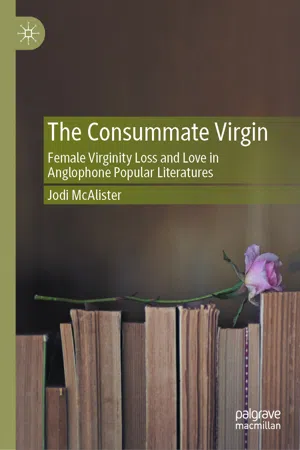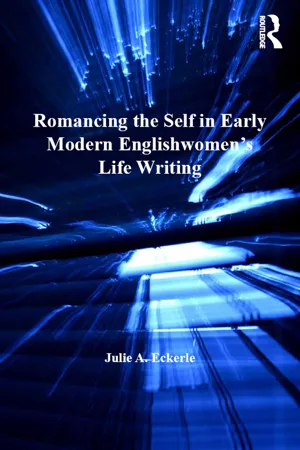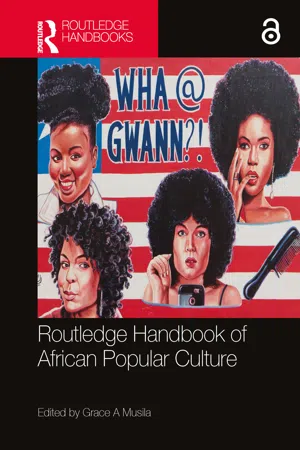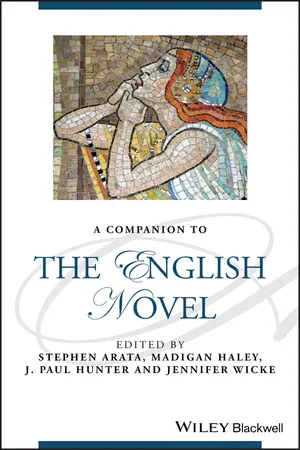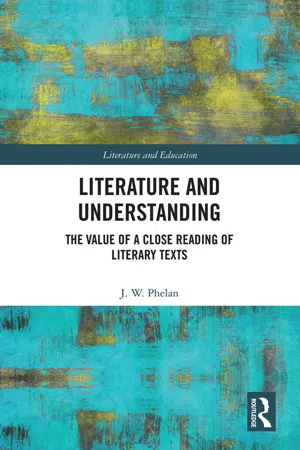Literature
Romance Fiction
Romance fiction is a genre that focuses on romantic love and relationships. It typically features a central love story and a happy ending. Themes often include love, passion, and emotional connections between characters. Romance fiction can encompass various subgenres, such as historical romance, contemporary romance, and paranormal romance.
Written by Perlego with AI-assistance
Related key terms
Related key terms
1 of 4
Related key terms
1 of 3
9 Key excerpts on "Romance Fiction"
- eBook - ePub
30-Second Literature
The 50 most important forms, genres and styles, each explained in half a minute
- Ella Berthoud(Author)
- 2020(Publication Date)
- Ivy Press(Publisher)
But the romantic novel in its modern mass-market form emerged in the 1930s when US publishing house Mills and Boon began to create escapist, romantic fiction. Though far more sophisticated than these commercial stories, the novels of Jane Austen, such as Pride and Prejudice (1813), are thought by many to have sowed the seeds of the genre in Britain and beyond, but writers across Europe, China and India were simultaneously writing similar tales. A romantic novel describes the love of two people who, after various setbacks, come together. Once exclusively heterosexual, the genre today more truthfully reflects society, with The Doctor’s Discretion (2017) by E.E. Ottoman being a contemporary example of gay romantic fiction. There are many subgenres catering to readers’ various romantic fantasies, including the historical romance, such as those of Georgette Heyer, paranormal romance, and the erotic, such as Kathleen Woodiwiss’s The Flame and the Flower (1972), the latter genre having been disdainfully termed ‘bodice rippers’ by the literary establishment. Characterized by sexual tension, desire and idealism, romantic books gratify the reader’s deepest yearnings, not just for romance but for a happily-ever- after ending. 3-SECOND PLOT A romantic novel depicts the course of romantic love between two people with an emotionally satisfying and optimistic conclusion. 3-MINUTE THEME Traditionally sexist and lacking in diversity, in the past, romantic novels tended to reinforce stereotypes, supporting the view that women were the passive objects of men’s desire. But in recent years, romances have brought in diverse characters – men and women of different races and sexual persuasions - eBook - ePub
The Consummate Virgin
Female Virginity Loss and Love in Anglophone Popular Literatures
- Jodi McAlister(Author)
- 2020(Publication Date)
- Palgrave Macmillan(Publisher)
heroines and, more recently, on-the-page representations of virginity loss. It is the natural genre to turn to next in this examination of the ways in which the romantic narrative dominates and affects female virginity loss experiences.Romance Fiction is not a static genre, and the ways in which the link between love and sex manifests has altered over time. Jayashree Kamblé accounts for this in her description of the romance novel as a double helix, made up of the intertwined strands of “romance” and “novel”. Kamblé argues that “the word ‘romance’ in the mass-market romance novel is actually the adjective ‘romantic’ used to describe an element that is ‘conducive to feelings of romance’ (i.e. supportive of a love affair)” (14–15). What is considered “romantic” is historically specific and changes over time—further drawing on this genetic metaphor, various alleles (which we might think of as traits or tropes) are dominant or recessive depending on the historical and cultural context (Kamblé 15). The alleles which express the relationship between love and sex in the novel are no exception, and a reading of the modern romance shows that compulsory demisexuality is certainly currently a dominant allele. Likewise, the alleles which govern the portrayal of virginity loss have not been static, and the genre’s relationship to virginity has undergone considerable shifts. The size of the genre means that contained within it are a multitude of sub-genres, and the tropes of these sub-genres also affect the ways in which love, sex and virginity are textually realised. In this chapter, after a brief overview of the history of the scholarship on romance, I examine historical romance fiction; that is, Romance Fiction written by contemporary authors set in the past, often in nineteenth-century England. In the next chapter, I examine the contemporary category romances published by Harlequin Mills & Boon . I focus specifically on representations of virgin heroines , but it should be noted that romance is a large genre and contains many sub-genres outside the two I will be exploring here. In addition, while I believe compulsory demisexuality is inherent in the genre as a whole, the way it manifests in novels with non-virgin heroines - eBook - ePub
Caught in Play
How Entertainment Works on You
- Peter G. Stromberg(Author)
- 2009(Publication Date)
- Stanford University Press(Publisher)
7Romance and the Romantic
AMONG THE CLEAREST EXAMPLES of romantic realism in our society is the romance story itself, whether embodied in a novel, a film, or some other genre. When we engage a romantic story we enter a world in which we glimpse the possibility of a perfect love relationship, we despair over the obstacles in the way of its realization, and in the end we experience a thrill as those obstacles are overcome. Romance holds particular interest for me in this book in that it is a good example of a cultural form seeming so close to our day-to-day world that at times we feel it spills over into mundane reality. This distinguishes the romance from many other varieties of romantic realism. Few of us will ever experience anything approaching being in charge of an intriguing murder investigation or leading a band of adventurers on a quest. But most of us will experience a romantic relationship that contains all the elements of the romantic story: unfulfilled longing, erotic attraction, obstacles to fulfillment, and moments (however brief) of perfect union.In this sense, the romance offers a useful opportunity to examine one of the central ideas of this book, the notion that there are strong affinities between becoming caught up in play and becoming immersed in interaction with other people. After all, the word romance can be used to refer either to a kind of fiction or to one kind of intense interaction in the day-to-day world. What are the implications of this overlap?Perhaps the most obvious question to ask about the overlap between romance and romantic fictions is whether engaging the fictions has any influence over our actual approach to romantic relationships. (If it does, just how does this happen?) In this chapter I take romance as a case study and see if it is possible to be more specific about how playful engagement with romantic fictions and romantic relationships in the day-to-day world intersect. - eBook - ePub
- G. R. Thompson(Author)
- 2011(Publication Date)
- Wiley-Blackwell(Publisher)
generally understood to refer to improbable, imaginative, and symbolic stories distinctly different from the novel. Such a broad distinction, critically impressionist at best, was complicated by early nineteenth-century authors, especially Walter Scott and Nathaniel Hawthorne, whose hybrid fictions combined the factual properties of the novel and the imaginative reach of romance. By the end of the nineteenth century this hybrid form was very popular, despite the fact that some critics – fervid apologists for literary realism such as William Dean Howells – struggled in vain to distinguish between romance and the novel. (35)By the 1890s, as Scheick makes abundantly clear, the body of Anglo-American romances was characterized by remarkable popularity and bewildering variety, which Scheick has schematized under three large categories: eventuary romance , which emphasizes plot and action; aesthetic romance , which emphasizes a somewhat more passive aspect of “aesthetic appreciation”; and ethical romance , which breaks down boundaries between fact and fiction and generates a variety of forms that balance the “ethos of storytelling” with “life” or “realism.” Edgar Rice Burroughs's Tarzan of the Apes (1914) would be an example of event-centered romance; some of the romance forms that Henry James experimented with (such as The Turn of the Screw ) could exemplify the aesthetic mode; and works by writers like Richard Harding Davis, John Kendrick Bangs, Stephen Crane, Mary Austin, or Jack London represent varieties of ethical romance in Scheick's schema.3These categories, labels, and definitions provide useful loci for anyone entering the somewhat chaotic world of both popular and serious romance. Here, however, I would propose a simpler categorical scheme for American romance in the 1865–1914 period: - Julie A. Eckerle(Author)
- 2016(Publication Date)
- Routledge(Publisher)
Although the genre was, in its earliest manifestations, written primarily by men, it has long been associated with women because of its focus on love, tendency to digress, seeming encouragement of idle behavior, often scandalous or immoral subject matter (again revolving around love, or lust), and dedications or internal appeals to female readers. 8 This association with women worked in a circular fashion to demean the genre, its writers, and its readers even more. Therefore, whether belittled as trivial or attacked as powerfully dangerous, seductive, and immoral, romance was a genre that—so the moralists would have one believe—“good girls” did not read. Of course, the reality was much more complicated, and numerous studies have addressed the seeming contradiction between this “feminine” genre and the male intellectual world that actually created and marketed it, especially in the sixteenth century. Particularly useful is Helen Hackett’s Women and Romance Fiction in the English Renaissance, which traces the progression of women’s relationship to romance from imagined readers to real readers to writers, usefully reminding us that “the female readership came gradually to exist while also being exaggerated for rhetorical and satirical purposes” (67, emphasis added). In “Gendering Prose Romance in Renaissance England,” Lori Humphrey Newcomb garners a wealth of evidence to further debunk the myth of the female reader that was propagated by a “host of references in Renaissance texts to women reading prose romance” (121). This imaginary readership was often said to include, among other frightening scenarios, servant women who would drop all responsibilities and flee with the first available boy upon concluding a romance. But Newcomb exposes a much different reality, arguing that, “while romance attracted a large audience of both genders, its association with women readers became a powerful literary convention- eBook - ePub
- Grace A Musila(Author)
- 2022(Publication Date)
- Routledge(Publisher)
2012 , p. 310) since colonial times and one of the Western genres that have been avidly consumed by African readers and quickly adopted by African writers, more often than not in concordance with the formulaic pattern of ‘girl meets boy – they fall in love – complications occur – happy ending assured’. Obviously, romance is a conservative genre that generally sustains heteronormativity and a patriarchal order. However, considering different cultural settings with their specific gender stereotypes, it is important to concur with Stephanie Newell that in Africa:Specific readerships are not necessarily implied by particular genres as they are in the West: for example, men read Harlequin and Mills and Boon romances in West Africa in order to learn about women’s behaviour, and Ghana boasts a long tradition of male romance writers dating back to the mid-1940s.(2002, p. 4)If in the global North romance is said to be a typical female genre written and read by women, this is not necessarily the case in the global South, as my case study from Togo will also confirm. In contrast to Nigeria and Ghana, in francophone West Africa, local romance is a more recent phenomenon on the book market that used to be dominated by French outlets of the genre for a long time. Since the late 1990s, romance in French with a West-African setting was first widely promoted by a series published in Abidjan, Ivory Coast: the collection Adoras (literally: you will admire) of the publishing house Nouvelles Éditions Ivoiriennes. The collection features the slogan ‘Quand la lecture devient passion’ (When reading becomes passion)5 and was consciously created to fill the gap of love stories in a local setting while frankly aiming at commercial success (Moudileno 2008 , p. 120/121). Widely distributed and read in the entire francophone sub-region, the popularity of Adoras - eBook - ePub
- Stephen Arata, Madigan Haley, J. Paul Hunter, Jennifer Wicke(Authors)
- 2015(Publication Date)
- Wiley-Blackwell(Publisher)
Poetics, perhaps the single most influential authority over the first century of this survey. Nonetheless, critical reflection sustained a remarkably persistent set of concerns: the relation of the novel to other genres, most notably romance, epic, and the drama; criteria of plausibility informing character and action; the relation of the novel to the society that produces and consumes it; the moral dimensions of the form; the nature of narrative coherence.One critical consensus emerged very quickly: almost from its first mention, the new form of writing was defined through comparison with “romance,” most broadly as a representation of “familiar” experience and characters set against an idealized, “illustrious” world of love and martial prowess recounted in elevated prose. As William Congreve framed it in the preface to his 1691 novel, Incognita, “Romances are generally composed of the Constant Loves and invincible Courages of Hero’s, Heroins, Kings and Queens, Mortals of the First Rank, and so forth; where lofty Language, miraculous Contingencies and impossible Performances, elevate and surprise the Reader into a giddy Delight.” Novels, by contrast, “are of a more familiar nature; Come near us, and represent to us Intrigues in practice, delight us with Accidents and odd Events, but not such as are wholly unusual or unprecedented, such while not being so distant from our Belief bring also the pleasure nearer us” (Williams 1970, 27).Although Congreve presents novel and romance as rival, coexistent forms, critics increasingly evoked a triumphalist history, in which the new form, which was deemed “natural,” plausible, terse, and English, crowded aside the old, which was viewed as artificial, marvelous, extravagant, and French. Thus Delariviere Manley, without using the term “novel,” in 1705 prefaced her Secret History of Queen Zarah by contending, “The little histories of this Kind have taken the place of Romances, whose prodigious Number of Volumes were sufficient to tire and satiate such whose Heads were most fill’d with these Notions” (Williams 1970, 33). These “little histories” are not merely shorter than romances (an association central to the term nouvelle), and so “are much more agreeable to the Brisk and Impetuous Humor of the English - eBook - ePub
Genealogies of Emotions, Intimacies, and Desire
Theories of Changes in Emotional Regimes from Medieval Society to Late Modernity
- Ann Brooks(Author)
- 2016(Publication Date)
- Routledge(Publisher)
The history of love in the post-Enlightenment period has not been an uncontested one. As Evans (1998: 270) comments: “what we often accept as a fixed point in our culture is, in fact, one which has had diverse meanings. In particular what we can observe from this history is that love and romantic love most specifically has often been regarded as lower-class, irrational and deeply suspect.”In this case love is seen as “feminizing” challenging masculinity and undermining the traditional power structure. At the same time, love has been linked with greater autonomy for women and increased rights, while also leading to the domestication of men. So love can be seen as both a support for the powerless and at the same time a vehicle of oppression. Evans (1998: 273) is critical of the value of love arguing that: “Far from giving individuals a guide to the expression and articulation of emotional feelings, romance distorts and limits the possibilities of human relationships.”Love in Popular and Literary Fiction
One of the key drivers of love was the growth of popular and literary fiction which was the result of the growth of the print media. The impact of romantic fiction was both powerful and at the same time devastating. The historian Lawrence Stone comments in this regard: “… the romantic novel of the late eighteenth century and early nineteenth centuries has much to answer for in the way of disasterous love affairs and of impudent and unhappy marriages” (Stone 1977: 191).Illouz reflects on the fact that the growth of literary fiction through the print media led to a cultural malaise about the impact of such fiction in creating “a (false) sentiment of love” (Illouz 1998: 162). Illouz uses Flaubert’s Madame Bovary as an example of this malaise - eBook - ePub
Literature and Understanding
The Value of a Close Reading of Literary Texts
- Jon Phelan(Author)
- 2020(Publication Date)
- Routledge(Publisher)
Literary fiction as a subgenre of both literature and fictionThere is a tendency in the philosophy of literature, less conspicuous in the philosophy of fiction, to use the terms ‘literature’ and ‘fiction’ interchangeably. Yet the terms appear to track an important distinction; one recognised by publishers, librarians, booksellers and any reader who expects a different kind of read from the shelf marked ‘literature’ than from the shelf marked ‘fiction’.1 The problem is that in running the concepts ‘literature’ and ‘fiction’ together, no distinction is drawn between arguments that are sound only if the concept ‘literature’ is employed and arguments that are sound only if the concept ‘fiction’ is employed. As a result, the conclusions of such arguments are taken to apply indiscriminately to both literature and fiction, to the potential detriment of both. Some work needs to be done in order to determine what the conceptual relations are between literature, fiction and literary fiction. Once this is in place I can investigate the claim that the cognitive gain from reading literary fiction is generated from a reader’s engagement with literary fiction qua literature and not, as is too often assumed, qua fiction.There is a tradition that takes all literature to be fictional by definition. This view is summarised by Tzvetan Todorov when he says that literature is ‘imitation through language’ and as all imitation is not real but fictional then ‘literature is fiction’ (Todorov 1973: 7 italics in original). It is not clear, however, why we should join this tradition given that many works read and admired as literature are not fictional. Works admired for their literary qualities but which are not fictions include: Descartes’ Meditations, Gibbon’s Decline and Fall of the Roman Empire, some of George Orwell’s essays, and The Song of Solomon. Some works considered ‘literary’ include works based on fact which are fictionalised in their presentation such as Arthur Miller’s The Crucible
Index pages curate the most relevant extracts from our library of academic textbooks. They’ve been created using an in-house natural language model (NLM), each adding context and meaning to key research topics.
Explore more topic indexes
Explore more topic indexes
1 of 6
Explore more topic indexes
1 of 4

